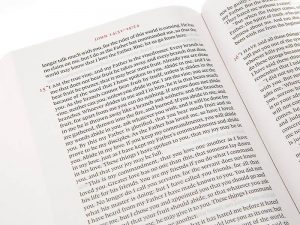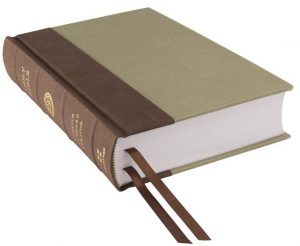 If you’ve ever been Bible shopping you might have heard of the term “reading Bible.” But what does that mean? Of course the Bible is for reading. But what is a reading Bible for, and why would you need one?
If you’ve ever been Bible shopping you might have heard of the term “reading Bible.” But what does that mean? Of course the Bible is for reading. But what is a reading Bible for, and why would you need one?
If you’re new to Bibles, or you’re just not aware of all the different types of Bibles, you should know what’s available to you. It could make all the difference in your experience with the Word of God…
There are all kinds of Bibles on the market today… kid Bibles, teen Bibles, study Bibles, chronological Bibles, interlinear concordance Bibles, Bible commentaries, large print Bibles, paraphrase Bibles, reader Bibles, and… well, you get the idea.
But when it’s overwhelming to decide what kind of Bible to get, it might be worth unplugging from all the features, bells, and whistles. It might be worth just getting a Bible that can speak to you… a simple, basic Bible. That’s where a reader’s Bible comes in.
What is A Reading Bible?
A reading Bible or reader’s Bible is a Bible printed more in the format of a novel rather than a complex religious text. Most regular Bibles have annotations, footnotes, chapter and verse number separators, and cross-references. Reader Bibles just have the scripture text and blank space, with maybe marks for new chapters.
Sometimes reading the Bible can be distracting with all the notes and numbers. And if you’re a Bible nerd like me, you want to read everything on the page and learn as much as you can. But sometimes it’s easy to lose your heart in apologetics and academics.
It’s healthy for us to step away from all the formal scholarship once in awhile and just read the Bible for what it is, allowing the story and message of the Word of God to capture us. We should aim to have an emotionally and spiritually intimate relationship with God.
I would consider a reading Bible to be opposite of a study Bible. Study Bibles have tons of resources and features to help you learn and understand all about the history, culture, theology, context, and literary themes of the Bible. In contrast, a reader’s Bible is just the text of scripture on a blank page and not much more.
Why Use A Reader’s Bible?
Personal anecdote time: right now, I am writing this on my WordPress backend. That’s the part of this website that you don’t see when you come here, but it’s where I create and edit the content you’re reading right now. I have a lot of tools and options to make quick edits and technical changes on the fly.
From my dashboard right now I can publish this post or save it as a draft. I can check the category tags I want it to have. I can even choose how I want this page to show up in Google. Back in the day, a lot of WordPress users would write their posts in a separate word processor (Microsoft Word) and then transfer it to WordPress.
Why? Well, a lot of users were distracted by all the tools they had surrounding their writing space on WordPress. Nowadays, WordPress has an automatic distraction-free writing feature. When I am in my content box writing away paragraph after paragraph, WordPress detects that and temporarily removes all my features. All I see is a white textbox just waiting for me to fill up with virtual ink.
Like I already mentioned, a reading Bible takes out the distractions of regular Bible reading and format scripture like a novel. It makes reading the Word of God a seamless and simple experience. It allows the reader to get lost in the story and message of scripture. No extra shiny objects to distract from allowing God to speak to you. Just God… breathed onto a page.
Distraction-Free Reading
I am into learning all the theology, Bible history, quirks of the original languages, crazy old testament laws, literary styles, cross-references, and so on and so on. But I admit that sometimes I take the study part of my Bible study a little too seriously and forget to meet with God in the process.
 I like for the Holy Spirit to fill my head with knowledge, but sometimes in my pride I don’t necessarily want the Lord to pierce my Heart with the double-edged sword that is His Word.
I like for the Holy Spirit to fill my head with knowledge, but sometimes in my pride I don’t necessarily want the Lord to pierce my Heart with the double-edged sword that is His Word.
A Reader’s Bible takes away the temptation to run off with books and study notes and hang out in my head. When I read the Bible with no annotations or verse separation I am forcing myself to just read the Word for what it is at face-value. It captures my heart and carries me into the message that God has written for us in scripture.
Sometimes when we read the Bible we get overwhelmed by the details like a student reading a textbook. Okay, how many chapters and verses should I read? Which chapter is a good stopping place? And what do all these footnotes and tiny numbers mean?
On the other hand, a reading Bible allows you to have deeply personal experience with God. When I want God to speak to me in a quiet whisper (1 Kings 19:11) while I am still drowsy in the morning, my reader’s Bible is the best choice for me.
Reading Bibles Vs. Study Bibles
Trust me, I know the value of a good study Bible. I think every student of the Bible should have a copy of Crossway’s ESV Study Bible. Studying and intellectualizing the Bible in your head is definitely a good thing. But in order for it to renew our minds we must also absorb it into our heart.
Look, when it comes down to it, a Bible is a Bible. If you have the Word of God treasured in your heart (Psalm 119:11) then you’re in good shape. Whether it’s the Bible App on your phone/computer, an e-reader, or in a book, the Bible is still precious. But there are different kinds of Bibles for a reason, and they have different uses.
A reader’s Bible has just the text of scripture and can envelope you like any good book, which is exactly what scripture should do. A study Bible, on the other hand, is specifically for learning and studying all about the Bible and its background, interpretations, etc.
If you only have two Bibles in your home, I would recommend one be a study Bible and the other a reader’s Bible. When you head off to a Bible study, you want to understand the word. But when you are reading to meet God, you need to be able to listen. For many of us, we need to cut out as many distractions as possible when we listen, including distractions in our own Bibles.
The Ancient Manuscripts
Before the printing press and fancy publishing companies, scripture was written by hand on scrolls of parchment and the oldest manuscripts were written on stone tablets. There were original manuscripts, and there were copies of those manuscripts. All hand-written. There were no such things as “chapters” and “verses,” just books of scripture.
The preface in the ESV reader’s Bible points out the original languages were written out with no breaks. No punctuation, no spacing, and even sometimes no vowels in the case of ancient Hebrew. INENGLISHTHEORIGINALBIBLICALMANUSCRIPTSWOULDHAVELOOKEDLIKETHIS. HRRTHLDSTHBRWMNSCRPTS!
Pages and pages of letters ran together were read by generations of Israelite patriarchs, priests, and scribes. So in a way, a reader’s Bible is taking us back to the roots of the Bible by providing us with scripture and only scripture. Luckily, our modern English reading Bibles have vowels, punctuation, and breaks between words and paragraphs. 😉
The Takeaway
I think Crossway (publisher of the ESV) stated the purpose of a reading Bible beautifully and summarily:
Atomization of the Scriptures can prevent us from encountering the chapters and verses of the Bible in the larger context of the documents that contain them. We miss out on the flow of the argument, the arc of the story, and the broader context of individual verses.
Like I said, get a study Bible and become a student of the Word. But make sure you are absorbing it as well. That’s specifically what reading Bibles are for, and that’s how I make sure I don’t run off to stuffy scholar land in my head every time I open a Bible.
What kind of Bible do you read, and how do you unplug from distraction? Comment below and let me know! I’ve love to hear how you interact with the Word and explore scripture in your own walk with God.
